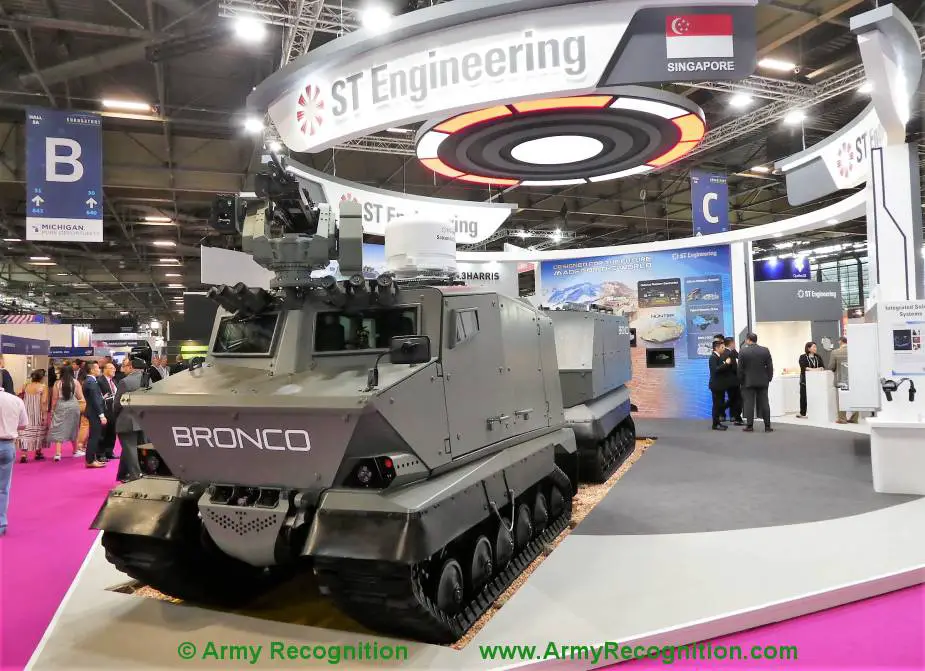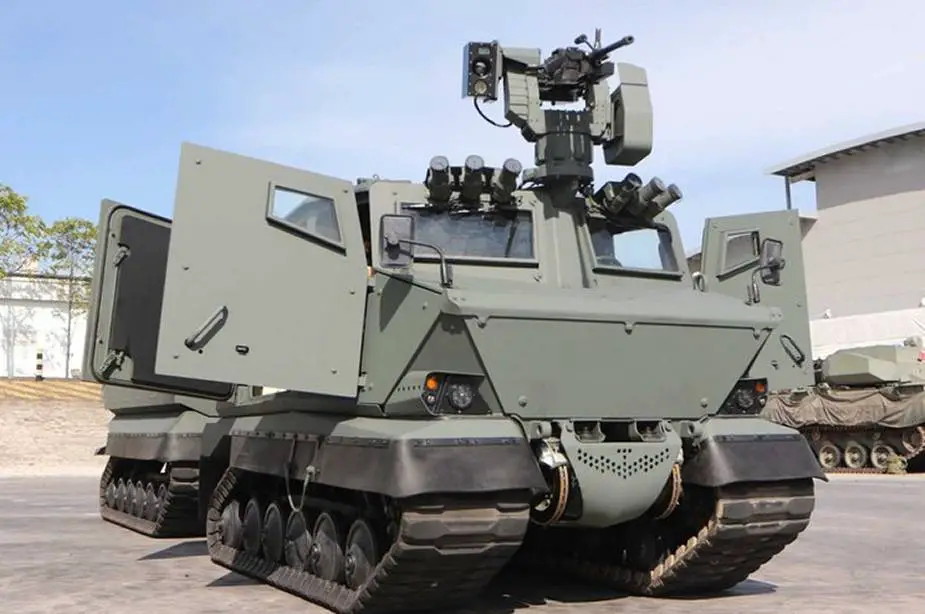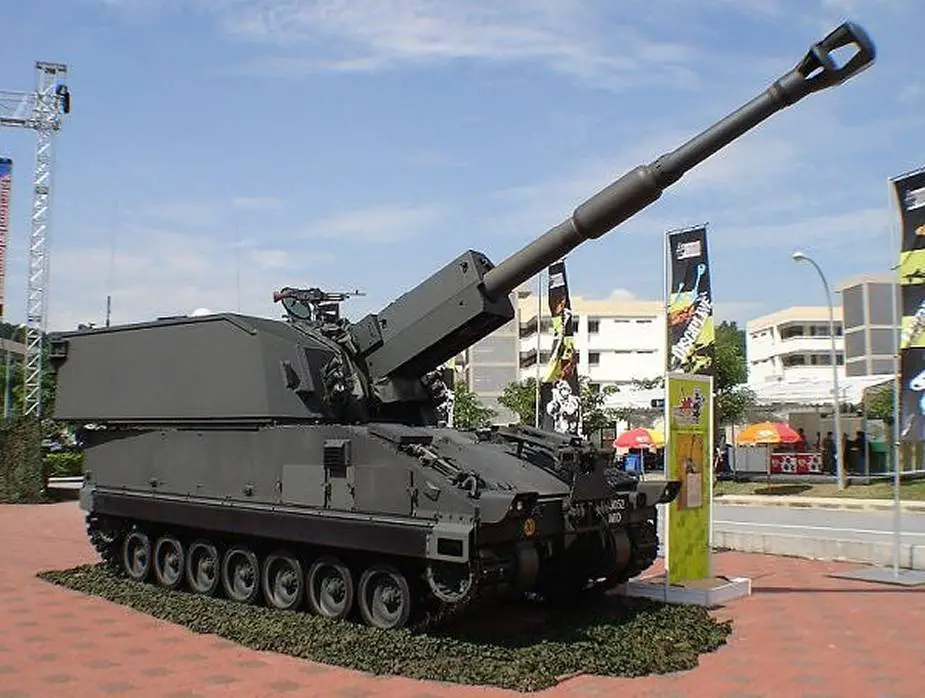Breaking news
Singapore Armed Forces to get Bronco 3 and Next Generation Howitzer from 2024.
The Singapore Army is expected to receive new self-propelled artillery and tracked carriers from 2024 as part of its platform renewal process. This is the first time a delivery timeline has been revealed for these two new platforms. Details of the Next-Generation Howitzer (NGH) are not yet disclosed, although Singapore’s Ministry of Defence (MINDEF) says it will replace the SSPH-1 Primus and FH2000 towed gun.
Follow Army Recognition on Google News at this link

ST Engineering Bronco 3 showcased at Eurosatory 2022 (Picture source: Army Recognition)
With a proven and battle-tested platform from over 50 years of deep engineering experience, the Bronco All Terrain Tracked Carrier is a fully amphibious all-terrain armoured vehicle with exceptional on and off-road mobility designed to conquer 82% of the world’s terrain in adverse environments. The Bronco has been in service since 2001. The Warthog, which was customised for the British Army, was deployed in Afghanistan for four years, clocking more than 300,000 miles, encountered 30 IED attacks with zero fatalities. With over 40 variants, the Bronco can be configured to support a wide variety of mission sets for modern armed forces, from combat support to combat service support missions.
Optimal for a range of missions and demonstrated outstanding armoured protection and manoeuvrability with an unsurpassed payload of 13,227 pounds. Featuring a completely re-engineered chassis incorporated with a V-shaped hull, it holds the largest capacity in the Bronco family; providing superior MMI armoured protection, maximise crew’s operating space and effectively deflects underbelly detonations.
With a capacity of 388 cubic feet, Bronco can easily accommodate a required payload of soldiers, equipment and cargo to provide total support for mission conditions.
At 16.4 tonnes, Bronco is highly manoeuvrable and amphibious - the ability to traverse across difficult terrain effortlessly at a top speed of 65 km/h at higher STANAG level protection, be it swamps, desert, snow or water bodies to satisfy the most demanding mobility requirements of expeditionary forces. Having completed winter and summer trials in the Arctic Circle and United Arab Emirates respectively, Bronco performs well under extreme temperatures ranging from -45°c to 49°C.
Incorporated with digital vehicle architecture – CANBUS and modern ergonomic interiors, Bronco’s modular design is engineered for the modern armed forces with low cost of ownership. Customisation of variants can be crafted to meet the strict requirements of our customers with the easy reconfiguration of Bronco. Suited for rapid deployment by air, land or sea freight, Bronco’s compact space envelope is compatible with most military transport aircraft such as C-130 or C-17 or a 40-foot ISO container via commercial transport.

The Bronco 3 will serve as the Next-Generation Armoured Tracked Carrier in Singapore. (Picture source: Singapore MoD)

Singapore Self-Propelled Howitzer 1 (SSPH 1) Primus (Picture source: Wikipedia)
The NGH to replace SSPH-1 Primus and FH2000 towed gun
The Singapore Self-Propelled Howitzer 1 (SSPH 1) Primus is armed with a 155 mm gun. Developed jointly by the Singapore Armed Forces (SAF), Defence Science and Technology Agency (DSTA) and Singapore Technologies Kinetics (ST Kinetics), it was officially inducted to the Singapore Artillery in 2004. At the time of introduction in 2002, SSPH Primus was recognized as the world's lightest 155mm, 39 calibre tracked howitzer of its kind.
The idea for a self-propelled howitzer within the SAF was developed in the early 1990s, with the aim of providing better fire support to the armour brigades in the Combined Arms Divisions. This new weapon system would require the ability to keep pace with the high tempo of armoured operations while providing the range, firepower and accuracy that the artillery is renowned for. The 155 mm self-propelled howitzer was seen as the obvious choice.
The decision to develop the Primus was made after a market survey in 1995 and 1996 of some of the world's best self-propelled guns from the United States (M109 Paladin), United Kingdom (AS90 Braveheart), Japan (Type 75) and Russia (2S3M1) found them either too heavy or too wide for local terrain.
Leveraging its experience with designing, developing and producing various towed artillery systems (the FH-88 and FH-2000) for the SAF, ST Kinetics, together with DSTA began the development of the Primus in earnest in 1996.
By April 2000, the first working prototype was rolled out, using a vehicle chassis adapted from a United Defense armoured chassis (the Universal Combat Vehicle Platform; UCVP) which includes components from the US M109 Paladin self-propelled howitzer, M2A3 Bradley IFV and M8-AGS. The next 2 years saw the system undergoing a series of comprehensive tests to ensure that the Primus was able to withstand the rigors required of it. As land in Singapore is scarce, firing tests were first done at the Waiouru Army Camp live-firing range in New Zealand as part of Exercise Thunder Warrior in February 2004. The guns have also participated in Exercise Wallaby at the Shoalwater Bay Training Area in Queensland, Australia.
In September 2002, the Primus was officially certified to have met the SAF's criteria, and was formally adopted in the SAF. Since then, this Artillery platform is utilised by the 21st Battalion Singapore Artillery as their primary weapon system for training and operation purposes.

FH-2000, or Field Howitzer 2000 (Picture source: Wikipedia)
The FH-2000, or Field Howitzer 2000, was developed by Singapore Technologies for the Singapore Army. It is a 155 mm/52-calibre towed howitzer gun. It fires projectiles to a maximum range of 42 kilometers using special extended range ammunition, that was field-tested in New Zealand. It has a crew of eight and uses a 75 hp diesel auxiliary power unit to give it a self-propelled speed of 16 kilometers an hour movement without towing.
The FH-2000 is a development of the FH-88 gun system, which was first produced in 1983 and uses many of the same components. Development of the FH-2000 began in 1990, with the first prototype produced in 1991. The initial prototype was developed further, and acceptance tests were completed in December 1993. The gun differs in a number of ways from the earlier FH-88 most notable is the longer 52-calibre barrel as compared to the 39-calibre barrel of the FH-88.
Additionally, ST Kinetics assisted Turkey in the design and manufacture of its own 155mm/52calibre Panter towed howitzer system, which is understood to be based on the FH-2000 design but upgraded locally with an uprated diesel Auxiliary Power Unit (APU) of 160 hp instead of the original 75 hp, thus giving it a self-propelled speed of 18 km/h as compared to 10 km/h for the FH-2000.
The Next-Generation Howitzer’s operating concept is expected to follow the BAE Systems Archer, with a fully automated self-loading 155mm gun and a crew of 2-4. Deliveries are likely to take place in 2024.


























